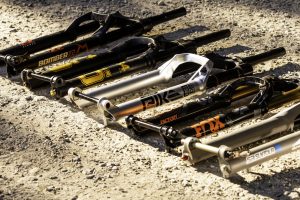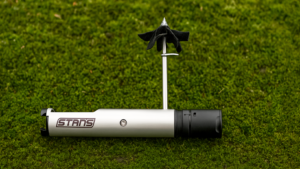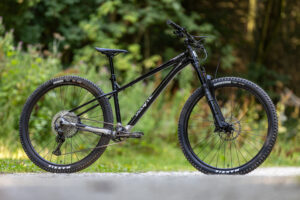Upside down forks have been hit-and-miss over the years, but Danny has fallen head over heels for the new Fox Podium.
Fox’s inverted Podium fork is heavy, expensive, and a faff to live with, but it’s the best enduro fork I’ve ridden
Fox’s new upside-down Podium fork isn’t pioneering – countless brands have tried inverted forks in the past. And it’s not even particularly eye-catching, particularly compared to the likes of Intend’s sculptural masterpieces. But it could just be the best iteration of the inverted format so far, and maybe even the best suspension fork for enduro riding, period. For our news story on the Fox Podium fork, click here.

Take away the decals and the Fox Podium is easy to miss. Maybe gold upper tubes would have helped it stand out.
Fox Podium fork need to know
- Inverted chassis using 36mm diameter sliders
- 3 travel options: 150mm, 160mm, 170mm
- 20mm axle
- Claimed to be almost as stiff as a Fox 40 (fore/aft) and about as stiff as a Fox 36 in torsion
- Only available at Factory level with Kashima coating and Grip X2 damper
- Improved bushing overlap
- Glidecore air-spring
- Weight from 2,695g
- Price is £2,199 / $1,999 USD / $2,679 CAD / €2,399
Those with long memories will know that this isn’t even Fox’s first crack at an inverted fork. Back in 2011 there was a prototype downhill model doing the rounds and being tested by Aaron Gwin and Gee Atherton, but it never made production. Something that often happens with inverted forks – they get knocked up to attract attention at a trade show, and then quietly get shelved when price, weight, and stiffness start to enter the equation. Critics might even say that the best place for an inverted MTB fork is hanging on the wall. So why now? What’s changed to entice Fox back to the drawing board and into the R&D workshop?
– Short of time? Click here to skip to the verdict –

I rode the Fox Podium in Leogang on a Scott Patron, and at home in the UK on a Santa cruz Bullit.
Stiffer is not always better
One of the reasons is attitude. Back then, no one really talked about tuning stiffness – stiffer was always better. But now there is an acceptance that more compliance and greater comfort can be better, or faster, depending on what metrics you use to judge these things by. Equally, weight is less important – since an upside-down fork will always be heavier than a right-side up design for a given stiffness.

With a big, 20mm thru-axle, prospective Fox Podium owners will need to budget for a new front wheel or hub adaptors.
Friction reduction
Another motivation was friction. Or, more specifically, running friction, the type that spikes in random situations where the fork is loaded up and starts to bind. It’s this stick-slip friction that’s impossible to compensate for by tuning the damping, so as a rider you just feel harshness, and experience less control and more fatigue.
Fox has already made great strides in this area with the new MY26 36 chassis, with its Glidecore air-spring, generatively designed arch, and increased bushing overlap, but it knew that there was even more performance potential on the table with the switch to an inverted design.

Intend BC’s upside down fork helped convince Fox that it was worth going inverted.
The final reason is that some key figures within Fox tried some of the existing products in the market, saw potential in them, and figured there were areas it could improve on.
And so here we are, with the production Podium fork, a premium proposition with a unique ride that delivers exceptional performance in some areas as long as you’re willing to accept some compromises in others. So let’s dig in and find out what those strengths and weaknesses are.

The fork comes with a post 200m brake mount, so you’ll need an adaptor to run a 220mm disc.
Design and specifications
But first a quick overview of the chassis itself. For starters, the Podium is designed for aggressive trail and all-mountain riding, for regular bikes and e-bikes, but the sweetspot really is enduro riding. The rougher and jankier the better.
Starting at the top, the Podium boasts a generatively-designed crown, where strength, stiffness, size, and weight targets are fed into an algorithm and a range of designs get spat out the other side. These get extensively developed and refined into the final version you see here.

Damping is as you’d expect on a conventional fork with Grip X2 damper, but the air-spring side is upside down, with the valve at the dropout.
‘Blind’ testing
As an indication, the Podium went through 3 crown iterations, 6 different axle designs, 2 upper tubes and 2 lower tubes before settling on the final version. Development testing was extensive, most of it conducted blind, where test riders didn’t know what changes had been made.
For production there are actually two crown options – 58mm and 68mm – depending on the external size of your bike’s head tube. Too small and the crown can look undersized on certain bikes.
The upper tubes are 47mm in diameter, while the lowers are 36mm. Fox has spent a lot of time maximising the bushing overlap – the distance between the upper and lower bushings that support the lowers as they slide up and down. The result is that there is 31% more bushing overlap than on an equivalent travel Fox 38 (174mm Vs 120mm), which has a big impact on fore-aft stiffness, reducing binding under situations like heavy braking, slap-down landings, and square-edge hits. And where conventional forks lose fore-aft stiffness as they gets deeper in the travel, upside-down forks actually do a better job of resisting those loads.

Those lower leg guards are carbon, and are removable if you want to show off the KashimaFox Podium inverted fork
Playing with the axle and the dropout design has allowed Fox to eke out a bit of extra bushing overlap, while mitigating any increase in axle-to-crown height. To the point where the Podium is only 1-2mm longer than an equivalent 38.
Built around a 20mm axle
Those dropouts clamp a 20mm x 110mm axle – one of the Podium’s main drawbacks. You’ll need a new downhill standard wheel to run in it, and the patience to get everything lined up and tightened correctly every time you remove it. If you find a 15mm thru-axle a pain, then the Podium probably isn’t the fork for you. That 20mm axle is vital for tying the lower legs together and mitigating against probably the upside-down fork’s biggest Achilles heel – torsional flex. While the axle and crown fight twisting forces on a conventional fork, the upside-down fork relies solely on the axle. So it needs a certain level of stiffness, and Fox said it couldn’t achieve that with a 15mm axle. To give you some idea, the Podium axle is 105g, while the 15mm Kabolt axle is just 46g.

To install the front wheel, the dropouts need to be manually aligned before inserting the axle. Tighten the non-drive pinch bolts in a 1-2-1 sequence, then cycle the fork a few times to align the lowers before repeating the procedure for the drive side.
However, the steel axle it ended up with was not the stiffest design it tested. The engineers and test riders tried steel and alloy axles of different thicknesses and stiffnesses and settled on one that seemed to offer the right blend of rigidity and wheel tracking. On the bench, Fox says a 170mm travel Podium is equivalent to a 160mm travel 36 in terms of torsional stiffness.
Moving inside, the Podium gets the Grip X2 damper launched last year. There’s four-way adjustment of high and low-speed compression and rebound damping, where the new Grip damper has a bigger base valve with more shims compared to its predecessor, as well as being pressure-balanced. Fox has tweaked the damper tune to compensate for the reduction in friction, so it actually has more compression damping than the stock 38 or 36 fork. Rebound damping has actually been reduced as there’s less unsprung weight to control.
Glidecore air-spring
On the air-spring side there’s Fox’s new Glidecore unit, where the air shaft ‘floats’ on rubber bushings (specifically Nitrile Butadiene) that keep it sliding smoothly even when the upper and lower tubes are not perfectly aligned. The bushings also flex a little vertically, which helps to smooth out direction changes as the fork switches from compression to rebound. An intrinsic benefit of the upside down design is that gravity keeps the seals bathed in lubricating oil for better sensitivity and durability.

The hose guides need to be set carefully to avoid any fouling.
This does mean that you set your air pressure and access the volume spacers at the dropouts rather than the crown (flipping the bike over to do this avoids losing lubricating oil). Fox now offers 5cc volume spacers to allow further fine tuning of the spring curve (the fork is fitted with two as standard). While there are no pressure bleeders on the upper tubes, Fox has incorporated them into the top caps. You’ll need sharp nails or small fingers to access the damping-side bleed nipple though.
What else? Well, the brake hose routing is not quite as sleek as on a conventional fork, the carbon leg guards keep those posh Kashima lower legs largely hidden from view, and Fox is still working on a mudguard solution – it’s due soon apparently.
Hefty on the scales
There’s no getting away from the fact that the Podium is a heavy fork. The 38 Factory Grip X2 I pulled off my Santa Cruz Bullit test bike weighed 2,520g with brake adaptor, while the Podium weighs 2,810g with the same length steerer tube. So 290g heavier. But swapping the Reserve wheel for a Race Face Turbine eMTB front wheel with 20mm adaptors added another 90g. So if weight is your ultimate concern, or you ride a lightweight trail bike, the Podium might not be the perfect solution.

Janky trails like the Bergstadl (used for the Leogang EDR round) are the Podium’s meat and potatoes.
Performance
I wasn’t sure I was going to like the Podium. The weight concerned me. The torsional rigidity was a worry. I doubted that it could bring enough extra performance to the ring to compensate for those drawbacks.
After 6,000m of descending in and around Leogang and Saalbach in Austria, I was totally smitten. The Podium is the best enduro fork I’ve ridden, hands down.

In at the jagged deep end on the Bergstadl trail.
Before I get into specifics, let me back up a little. Last year I went to the launch for the Grip X and Grip X2 dampers, and lapped up the presentation promising me the opportunity to add or subtract support without affecting grip. Sign me up, I thought. But my riding experience didn’t tally with the spiel. My hands hurt, the front wheel fought for grip, and I just kept winding off damping to try and soften the pounding. This initial experience was echoed on numerous other Grip-equipped forks through the year.
All this changed when I rode the new MY26 36 chassis (with Glidecore air-spring and increased bushing overlap). Given that the damping hasn’t changed at all, it’s Fox’s efforts to reduce friction that have allowed the Grip X2 and Grip X dampers to shine as originally intended. It wasn’t the damping that was harsh in 2025; it was the chassis that was binding.

With some tweaking and better familiarity, the Fox Podium was remarkably accomplished on faster, flowing bike park trails.
Well, if the MY26 36 chassis is impressive, the Podium fork is exceptional, taking this friction reduction and chassis optimisation to a whole new level, and providing the Grip X2 damper with the stage it deserves. One worthy of a standing ovation.
First of all, the grip and comfort is off the charts. When I hucked 20ft into a 4ft wide knot of baseball bat-sized roots, the Podium just took it. No deflection, no vagueness, no impact through the bars – just a catch worthy of a memory foam mattress.

The worst case scenario for an inverted fork – squaring off a banked turn with 105kg of bike and rider twisting and walking the lowers. But the Podium coped well. Check out that rear mech as well!
Getting hard on the brakes into a steep catch berm brought unflinching grip and solidity. Off-cambers levelled out. Washboard braking bumps didn’t even register. The front wheel found the path of least resistance when jagged serrations rolled in like waves during a storm.
Every turn of the compression dials I made yielded appreciable results, but adding support didn’t intensify the feedback through the bars. I can’t say I’ve done much more than scratch the surface of the tuning potential on offer with the podium – what’s really exciting is that it’s there for the taking.

Finding the path of least resistance and keeping fatigue at bay.
And what of the Podium’s inherent weaknesses – flex and weight? Well, as far as stiffness goes, I only noticed any kind of disconnection between steering input and wheel direction in one or two instances, while railing high G-force berms. And even then it was more of an observation than a flaw. I can’t speak for riders of a heavier build, but I didn’t find it excessively flexy in the slightest.
Weight is more of an issue. Again, it’s not a deal breaker as far as I’m concerned, but at slow speeds the extra mass is noticeable, and it does shift the weight balance of the bike forward. At first I kept getting pitched forward on small jumps and fly-offs, but whether through suspension adjustment or technique compensation, this sensation soon disappeared. It’s also worth noting that I rode the Podium on a 25kg e-bike, which may have helped mask the weight of the fork. Put it on a lightweight conventional bike and there’s a chance it might start to feel unbalanced.
Verdict
History has shown that there’s a serious soft spot for inverted forks in the marketplace, even if the performance of some notable models have not lived up to their looks. Riders are instantly drawn to the moto-styling, seemingly regardless of price tag. But the Podium seems to be the exception that proves the rule. Sure, it’s a wad of cash, but it’s relatively unremarkable to look at. There’s not the bling of an Intend fork. Or some of the Showa prototypes that have been floating around. But the understated looks belie the gold-standard performance. It delivers a ride quality that’s unmatched in any conventional enduro fork I’ve ridden, with next-level grip, versatile damping, and enhanced composure and confidence. When it comes to going inverted, colour me converted.
















